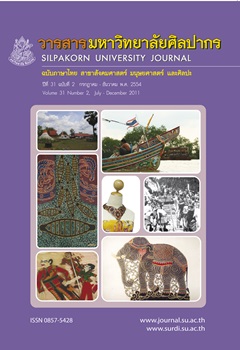การพัฒนาแบบประเมินการสอนระดับปริญญาตรี มหาวิทยาลัยศิลปากร The Development of a Teaching Evaluation Form For the Bachelor-Level Degree at Silpakorn University
Main Article Content
Abstract
บทคัดย่อ
การวิจัยครั้งนี้มีวัตถุประสงค์เพื่อ 1.) พัฒนาแบบประเมินการสอนระดับปริญญาตรีของอาจารย์ มหาวิทยาลัยศิลปากร โดยนักศึกษาเป็นผู้ให้ข้อมูล 2.) เพื่อแสดงหลักฐานบ่งชี้ความเที่ยงตรงเชิงโครงสร้างของแบบประเมินการสอนที่สร้างขึ้น ตามแนวทางของมาร์ช (Marsh 1987) ด้านความเที่ยงตรงเชิงลู่เข้า ความเที่ยงตรงเชิงจำแนก และความเที่ยงตรงข้ามกลุ่ม โดยกลุ่มตัวอย่างที่ใช้ในการวิจัยครั้งนี้เป็นนักศึกษาระดับปริญญาตรี มหาวิทยาลัยศิลปากรภาคปลาย ปีการศึกษา 2553 จำนวน 2,013 คน จาก 89 ชั้นเรียน เครื่องมือที่ใช้ในการวิจัยครั้งนี้ คือ แบบประเมินการสอนของอาจารย์โดยนักศึกษาเป็นผู้ให้ข้อมูล มีลักษณะเป็นมาตรประเมินค่า 5 ระดับ ทำการวิเคราะห์ข้อมูลโดยใช้วิธีการวิเคราะห์องค์ประกอบเชิงยืนยัน และการทดสอบความไม่แปรเปลี่ยนของโมเดลด้วยเทคนิคการวิเคราะห์โมเดลกลุ่มพหุ ผลการวิจัยครั้งนี้พบว่า
1. แบบประเมินการสอนของอาจารย์โดยนักศึกษาเป็นผู้ให้ข้อมูล ที่สร้างขึ้นตามแนวทางของมาร์ช (Marsh1987) โดยการสังเคราะห์ข้อมูลแบบประเมินการสอนจากทุกคณะวิชาของมหาวิทยาลัยศิลปากร มีความเชื่อมั่นและอำนาจจำแนกอยู่ในระดับดี ประกอบด้วยองค์ประกอบย่อย 10 องค์ประกอบ ได้แก่ การเห็นคุณค่าในการเรียนของผู้เรียน ความกระตือรือร้นของผู้สอน การเตรียมการสอน สภาพแวดล้อมการเรียนรู้ทางกายภาพ ปฏิสัมพันธ์ภายในชั้นเรียน ความเป็นมิตรของผู้สอน ความสามารถในการถ่า่ยทอดความรู้ของผู้สอน ความเหมาะสมของเกณฑ์การวัดและประเมินผล งานที่มอบหมาย ปริมาณงานและความยาก
2. โมเดลองค์ประกอบเชิงยืนยันอันดับหนึ่งของแบบประเมินการสอนที่สร้างขึ้น มีความสอดคล้องกลมกลืนกับข้อมูลเชิงประจักษ์ใ์นระดับดี และผลการศึกษาความเที่ยงตรงเชิงลู่เข้า้สรุปได้ว่า่ข้อคำถามทใี่ช้วัดในแต่ละองค์ประกอบมีความเหมาะสมที่ใช้วัดคุณลักษณะแต่ละองค์ประกอบย่อยทั้ง 10 องค์ประกอบ
3. โมเดลองค์ประกอบเชิงยืนยันอันดับสองของแบบประเมินการสอนที่สร้างขึ้น มีความสอดคล้องกลมกลืนกับข้อมูลเชิงประจักษ์ในระดับดี และผลการศึกษาความเที่ยงตรงเชิงจำแนก สรุปได้ว่าแต่ละองค์ประกอบมีความซ้ำซ้อนกันต่ำ เหมาะสมต่อการจำแนกเป็นองค์ประกอบของการประเมินการสอน
4. ผลการวิเคราะห์กลุ่มพหุ โดยแสดงผลการทดสอบความไม่แปรเปลี่ยนของรูปแบบและพารามิเตอร์ขององค์ประกอบในโมเดลองค์ประกอบเชิงยืนยัน พบว่าโมเดลการประเมินการสอนทั้ง 3 กลุ่มสาขาวิชา ได้แก่ ศิลปะและ ประยุกต์ศิลป์ มนุษยศาสตร์และสังคมศาสตร์ วิทยาศาสตร์ เทคโนโลยี และวิทยาศาสตร์สุขภาพ เฉพาะรูปแบบโมเดลมีความไม่แ่ปรเปลี่ยนทุกกลุ่มโมเดลมีลักษณะเป็นแบบเดียวกันนั่น คือ การประเมินการสอนของอาจานย์โ์ดยนักศึกษาระดับปริญญาตรี มหาวิทยาลัยศิลปากร ประกอบด้วยองค์ประกอบ 10 องค์ประกอบ แต่ค่าพารามิเตอร์มีความแปรเปลี่ยนไปตามกลุ่มสาขาวิชา ดังนั้น โมเดลการประเมินการสอนที่ผู้วิจัยสร้างขึ้นจึงมีคุณภาพด้านความเที่ยงตรงข้ามกลุ่ม
คำสำคัญ: 1. แบบประเมินการสอน. 2. ความเที่ยงตรงเชิงโครงสร้าง. 3. การวิเคราะห์องค์ประกอบเชิงยืนยัน.4. การทดสอบความไม่แปรเปลี่ยน.
Abstract
This research aimed 1.) to develop a teaching evaluation form for a bachelor’s degreeat Silpakorn University 2.) to show the evidence of construct validity of the teaching evaluation form,according to Marsh (1987) ’s theoretical concept, in terms of convergent validity, discriminant validityand cross validation analysis. The samples used in this study were 2,013 undergraduates from 89classes at Silpakorn University in the second semester of the academic year 2010. The research toolused in this study was the teaching evaluation form by students, a five-rating scales questionnaire.Data analysis was done by using confirmatory factor analysis, and tested the invariance of the modelby analytical techniques, multigroup model analysis. The results of this study showed the following:1. Factors of the teaching evaluation form for a bachelor’s degree at Silpakorn University,based on the guidelines of Marsh (1987) from the synthetic evaluation data of all teachingfaculties of the university, had good reliability and good discrimination. The factors were the value ofstudent learning, enthusiasm of the instructor, teaching preparation, learning environment, physicalinteractions in the classrooms, friendliness of the instructor, the ability to transfer knowledge ofthe instructor, appropriate criteria to measure and evaluate, assignment, workload and difficulty.2. The first order confirmatory factor analysis of a teaching evaluation form was created and inharmony with the empirical data was a good fit. The output analysis of convergent validity concluded that thequestions used to measure each factor were appropriate to contain in the 10 sub-attributes for each factor.3. The second order confirmatory factor analysis of a teaching evaluation form was created andin harmony with the empirical data was a good fit. The output oriented discriminant validity concludedthat each factor was less overlapped and suitable as a component of the teaching evaluation.4. From the results of multigroup analysis, the test of invariance model parameters and compositionof elements in the confirmatory factor analysis model, it was found that the evaluation model with three fieldsof study included Art and Applied Art, Humanities and Social Sciences, Science -Technology and HealthSciences. Only form of the model was invariant all groups. The model had the same characteristics as thatwas the evaluation of teaching by undergraduate students at Silpakorn University, consisted of 10 components,but the parameters were varied according to the fields of study. Therefore, the teaching evaluation modelwas qualified with cross validation.
Keywords: 1. Teaching Evaluation Form. 2. Construct Validity. 3. Confirmatory Factor Analysis.4. Invariance Test.


